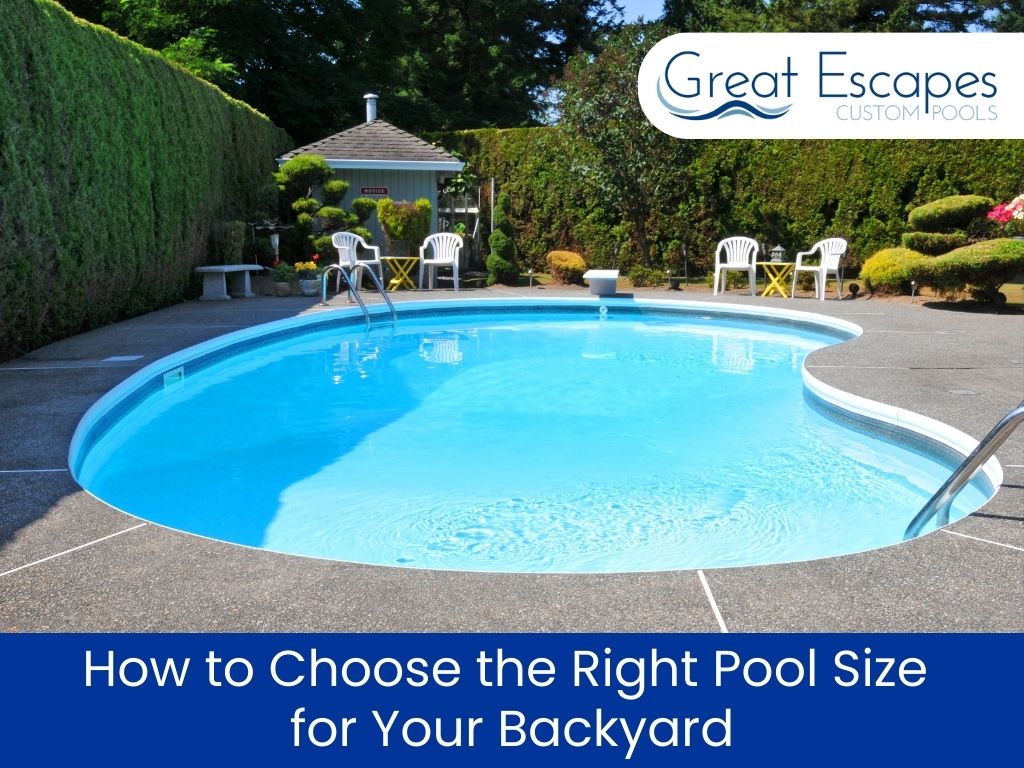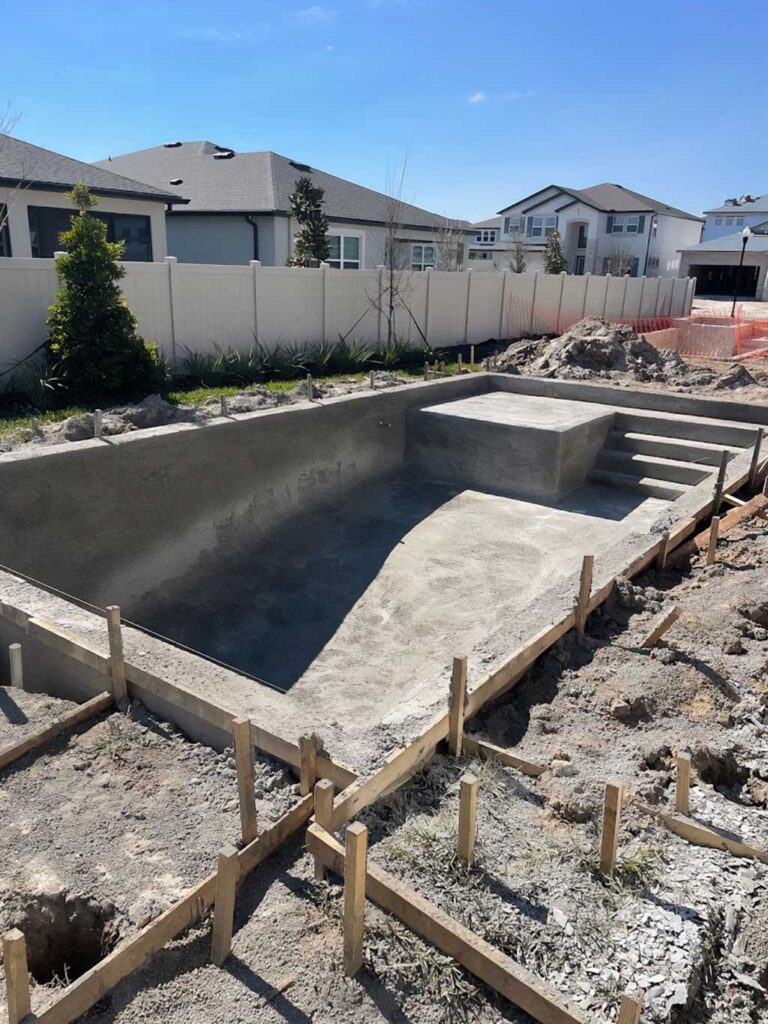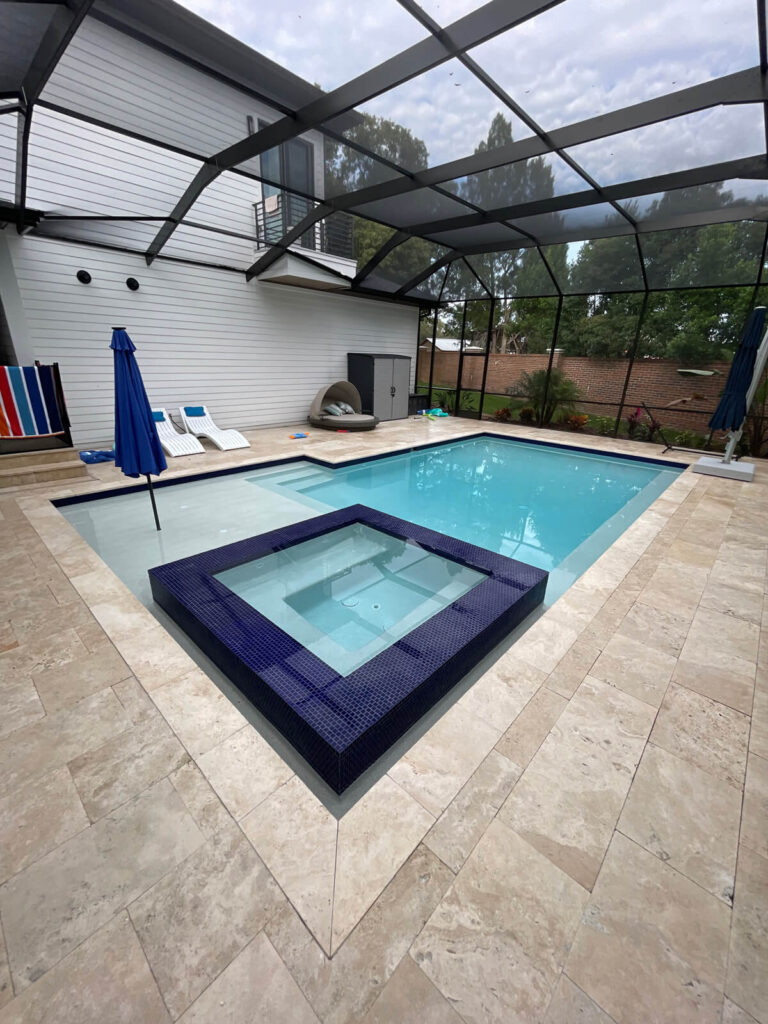How to Choose the Right Pool Size for Your Backyard

Have you decided to add an inground pool to your Florida backyard? Congratulations!
You’re probably thinking about a million different factors, but before you get ahead of yourself, we want to remind you that your pool size matters.
Different pool sizes (and shapes) suit different outdoor spaces. You need to feel confident that you’re choosing the right size to accommodate other entertainment areas, such as dining and firepit features. You also need to know that you’ll have space to maneuver around the pool comfortably and safely.
If you choose a pool design that’s too small, you can limit the functionality and focus of the swimming area. If you add a pool that’s too large, you could detract from the rest of your outdoor space.
These factors, as well as construction and equipment costs, should push you to consider the size of your new pool carefully. But don’t worry – we’re here to help you out.
Check out this guide to learn about the pros and cons of different inground pool sizes, then determine which is right for your property.
1. Assess Your Space & Needs

Your first step is to understand your unique property requirements. How big is your space, and what limitations does your backyard have?
Although you can start this process on your own, it’s a good idea to contact a local pool builder to make sure you’re evaluating all of the possible restrictions.
You’ll also need to familiarize yourself with local regulations, zoning requirements, and even your neighborhood HOA. These might present limitations regarding your pool’s size or enclosures. Speak with a local pool contractor to ensure you’re aware of all the legal guidelines.
Once you understand the logistical and regulatory requirements for various inground pool sizes, think about your personal requirements. How will you use this pool, and how do your goals influence its size and shape?
For example, if you want to swim laps, you’ll need to design a pool that’s long in length and conducive to that kind of activity. Similarly, if you’re adding a pool for therapeutic or entertainment purposes, you may want to design a smaller pool that heats up faster.
2. Understanding Pool Shapes & Sizes

You’ve probably already been thinking about your pool’s size, but have you given much thought to its shape?
Shape plays a big role in sizing. Freeform pools take up more space but don’t necessarily require more water volume. A rectangular pool, on the other hand, can maximize space and size but offers less design creativity.
As you brainstorm ideas, consider the dimensions of your space in tandem with your personal style preferences. The size and shape of the pool will impact many things, including its…
- Maintenance requirements
- Functionality and purpose
- Overall aesthetic appeal
Comparing Large vs Small Pools
Larger, more rectangular pools offer more space for swimming, entertainment, and exercise. This can make them ideal for families or individuals who enjoy hosting large gatherings.
However, larger pools typically also require more maintenance, which can result in higher costs for chemicals, cleaning equipment, and professional services. Additionally, the initial construction costs for a larger pool are usually higher due to the increased materials and labor involved – often costing more than $40,000 to install
Furthermore, larger pools require more water to fill, leading to higher water bills, and consume more electricity to operate filtration systems and heating.
In contrast, smaller pools are more suitable for compact spaces or individuals with limited budgets. They require less maintenance in terms of cleaning and chemical treatments, resulting in lower ongoing costs. Construction costs for smaller pools are also generally lower due to the reduced materials and labor required (sometimes under $20,000).
Additionally, smaller pools consume less water to fill initially and require less electricity to operate, leading to lower water and energy bills.
However, the main drawback of smaller pools is their limited space, which may not accommodate certain activities such as lap swimming or large gatherings.
Ultimately, the choice of pool size should be based on a careful evaluation of your space, budget, and lifestyle preferences. Consider how your family will use the pool, and take a look at your monthly budget for maintenance, water, and energy.
Not sure what kind of pool suits your goals? Talk to one of our Great Escapes representatives. We’ll help you assess your needs and preferences, then make the right call.
3. Budget Considerations

When considering the financial aspects of choosing a pool size, you’ll want to evaluate both the initial construction costs and the long-term expenses, as we touched on above.
Larger pools typically incur higher upfront construction costs due to the increased materials and labor required for excavation, installation, and finishing touches like decking and landscaping. These costs can vary significantly depending on factors such as the size, shape, depth, and complexity of the pool design.
Conversely, smaller pools generally have lower initial construction costs, making them more budget-friendly options for homeowners with limited funds or smaller outdoor spaces.
Pool Financing Options
There are many pool financing options available to Florida homeowners. Most homeowners will choose between…
- Personal loans
- Home equity loans
- Lines of credit
- Or builder-offered financing plans
Create Your Dream Pool Today with Easy and Hassle-Free Financing! Learn More
Additionally, homeowners may be eligible for incentives such as rebates or tax credits for installing energy-efficient pool equipment, such as variable-speed pumps or solar heating systems, which can help reduce long-term operating costs. You’ll want to consider these factors upfront before starting on your pool’s construction.
All in all, you’ll need to carefully assess the financial implications of installing different pool sizes, as well as your financing options and incentives. Doing so will help you make an informed decision that aligns with your specific budget and long-term financial goals.
4. Practical Considerations
You know how you want to use your pool for fun, exercise, and entertainment – but now it’s time to think about the logistical side of things to determine the most suitable location and size for your pool.
Pool Placement
Firstly, assess your outdoor space to determine the most suitable place to put your pool. Pay attention to factors such as available space, terrain, soil conditions, and proximity to utilities and property lines.
You’ll need adequate space not only for the pool itself but also for necessary equipment and accessories such as pumps, filters, heaters, and cleaning tools. By planning the placement of these components, you can better optimize your pool’s functionality and accessibility while minimizing potential obstructions or safety hazards.
Speaking of safety, how will you adhere to safety measures to protect both users and bystanders?
Making Your Pool Safe
Depending on the size of your pool and where you’re installing it, you may need to consider adding safety barriers such as fences or walls around the pool area to prevent unauthorized access, especially for households with children or pets.
Additionally, incorporating safety features like depth markers, slip-resistant surfaces, and emergency equipment such as life rings or reaching poles enhances overall safety and compliance with local regulations. Proper lighting around the pool area also improves visibility and reduces the risk of accidents, particularly during nighttime use.
Pool Maintenance
Lastly, think about your pool’s future maintenance requirements. Larger pools typically require more frequent cleaning, chemical treatments, and equipment maintenance compared to smaller pools due to the greater volume of water and surface area.
Regular tasks include skimming debris, vacuuming the pool floor, checking and adjusting chemical levels, and inspecting and servicing filtration systems and pumps. Additionally, incorporating features such as automatic pool covers or energy-efficient equipment can help streamline maintenance efforts and reduce operational costs in the long run.
5. Seeking Professional Guidance
The truth is, there is a lot to consider when designing an inground pool. That’s why it’s best to consult with a pool installation expert before making any permanent decisions.
A Florida pool installer will have the knowledge and experience needed to help you maximize your pool’s functionality and aesthetics. They’ll also provide site evaluations and 3D renderings to help you visualize your pool’s design and size.
Installing a pool is a big decision – and not something you should rush into lightly. Make sure you’re getting the professional advice and guidance you need.
Interested in Adding a Pool to Your Property? Let’s Talk.
No two pools are exactly the same, so as you embark on this installation journey, you’ll need to think carefully about what you want and need from your design.
At Great Escapes, we’re committed to helping homeowners in the St. Petersburg area select the ideal inground pool sizes and shapes for their properties. With our help, you can build the pool of your dreams in as little as six weeks.
To get started, schedule your free consultation with our crew. We’ll visit your property, then help you select the best pool size and structure.





